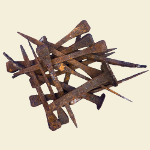Artifact: Ham

Materials: Ham
Dimensions:
Date:
Origin:
Collection: WikiMedia Commons
License: Public Domain
Ledger Entry: Venison Ham

Department: Local Payment
Customer: George Johnstone
Ledger Page: 269
Imported From:
Product Description
Though pork was a popular meat in Colonial America, it was usually only eaten fresh seasonally. The rest of the time, people consumed cured pork products such as ham. Ham is the cured rear legs of a pig. Ham was usually produced with a dry curing process, by applying salt, saltpeter, and sugar and then smoking the meat.
Citation: Katharine E. Harbury, Colonial Virginia's Cooking Dynasty (Columbia: University of South Carolina Press, 2004);; Andrew F. Smith, ed., The Oxford Companion to American Food and Drink (New York: Oxford University Press, 2007).
Historical Price: 12 shillings, 6 pence; Modern USD: $
Product Variations
Ramsay occasionally took payment in goods rather than currency. The databases record two entries for ham, one entry on Captain George Johnstone's account “for sundries paid for vennison ham” at the rate of twelve shillings and six pence, and the other was a corresponding entry on William Ramsay's account for the same day receiving the ham at twelve shillings and six pence.






